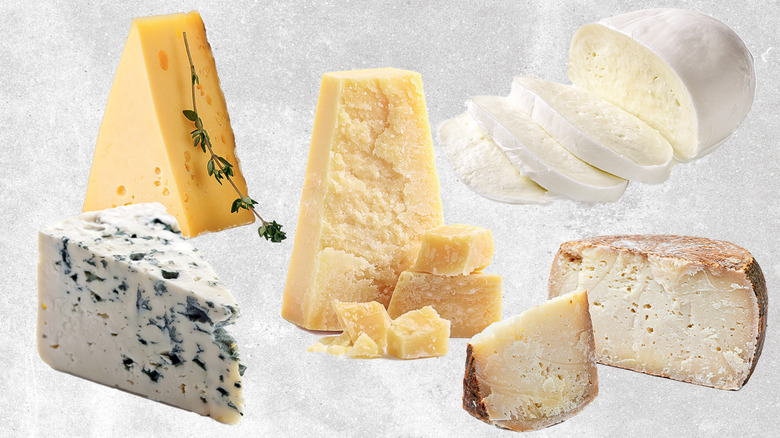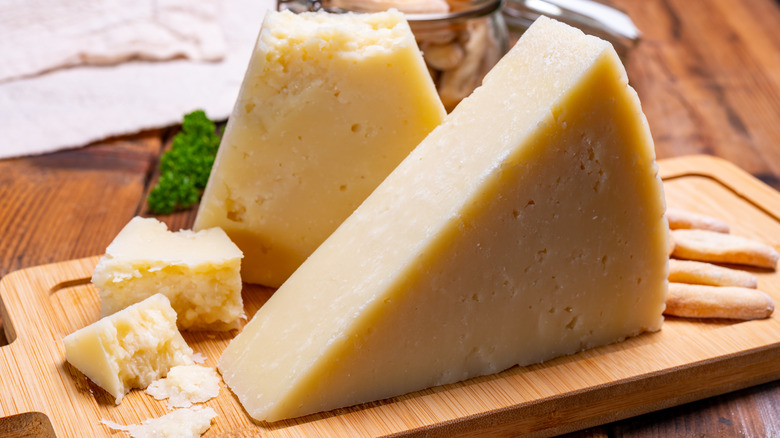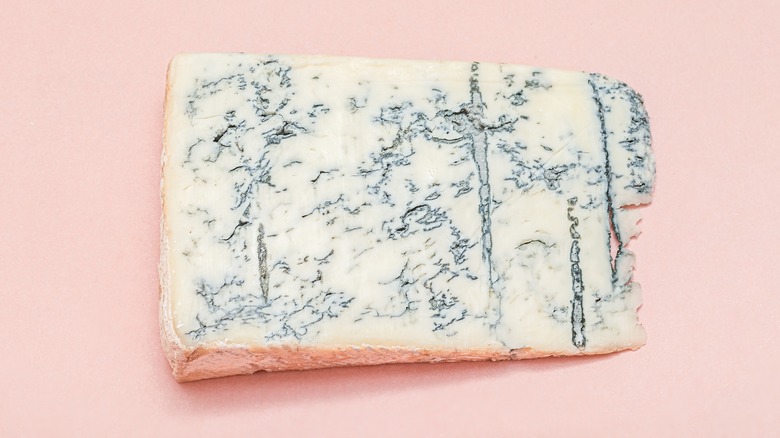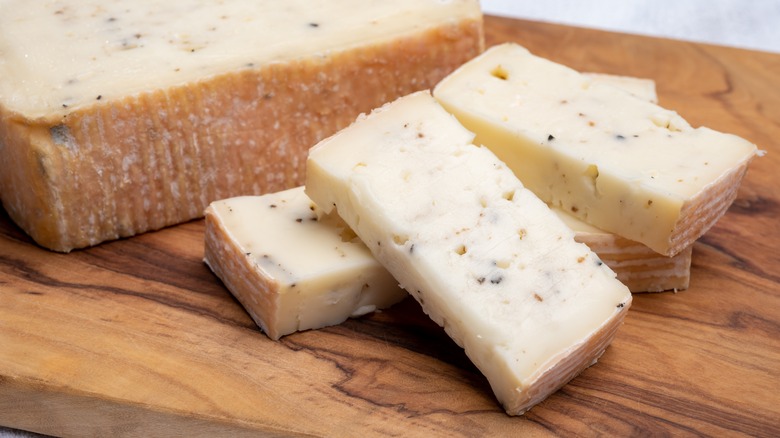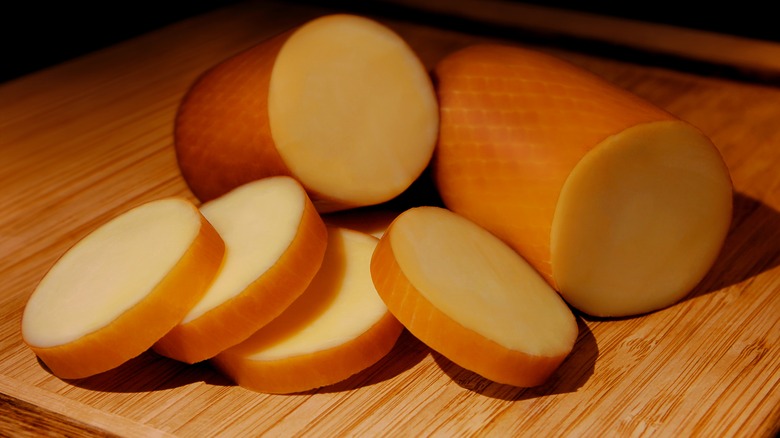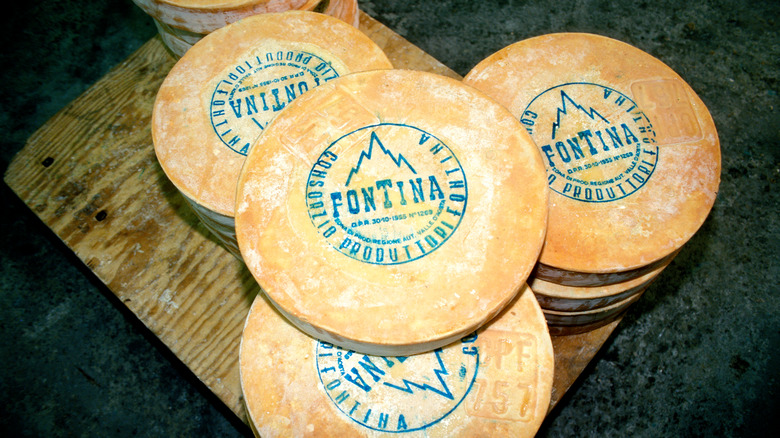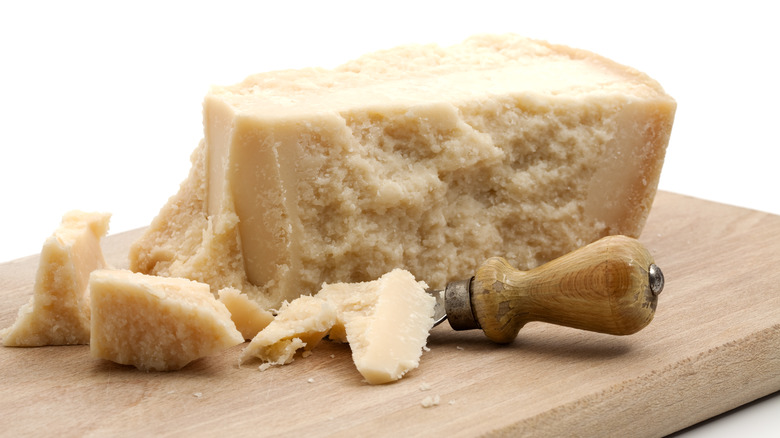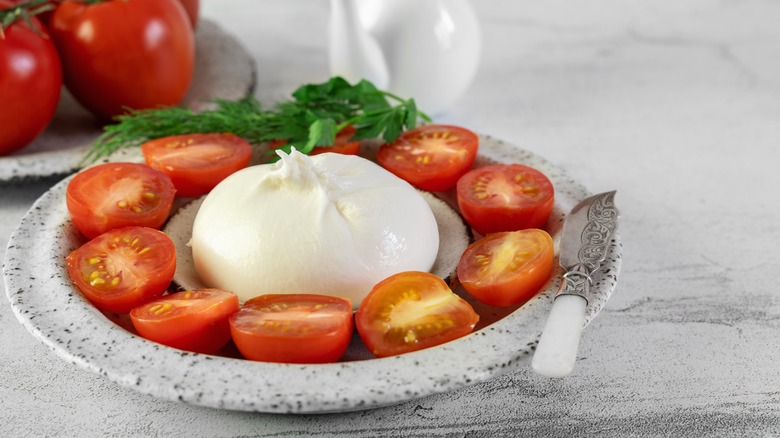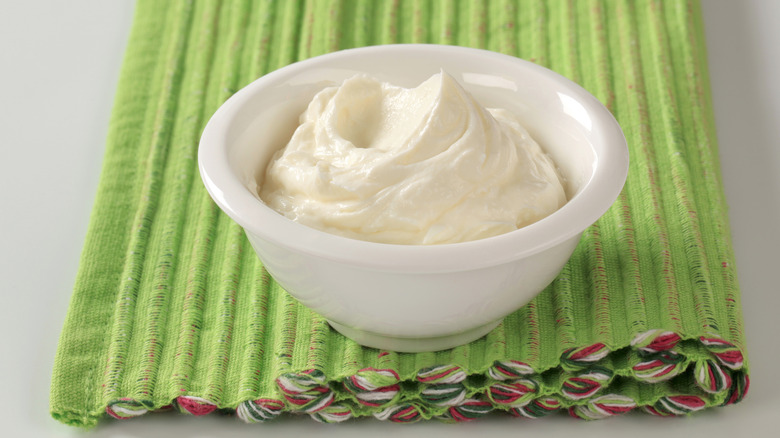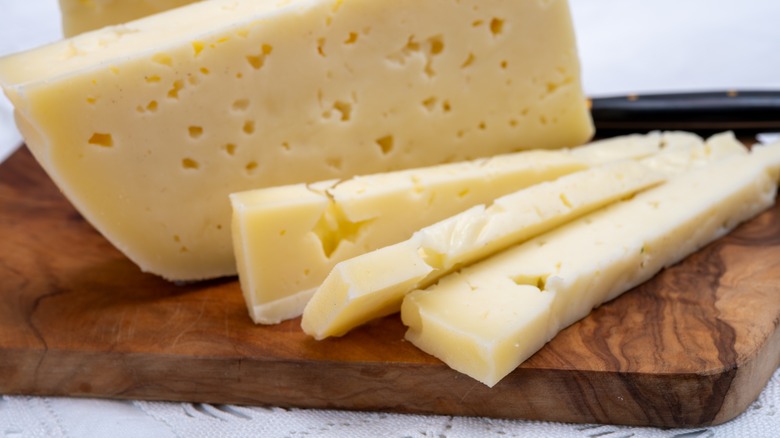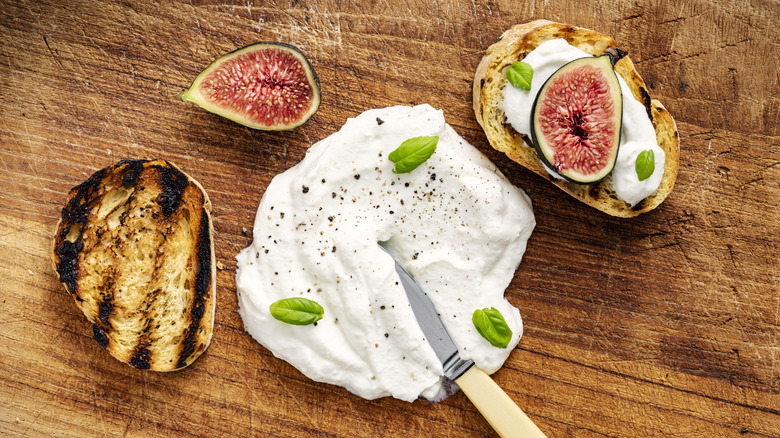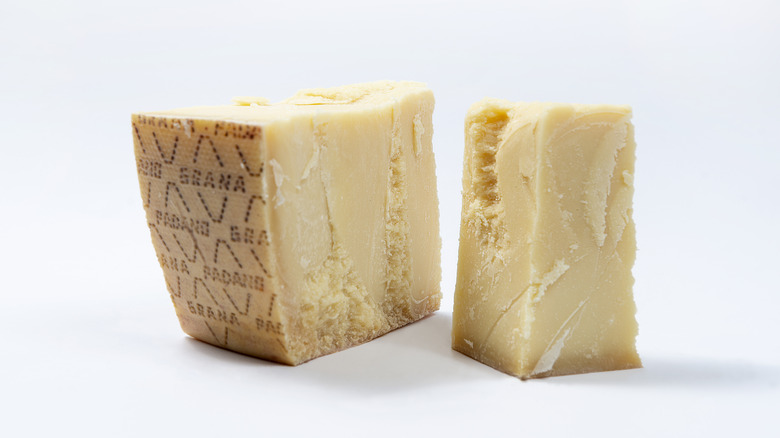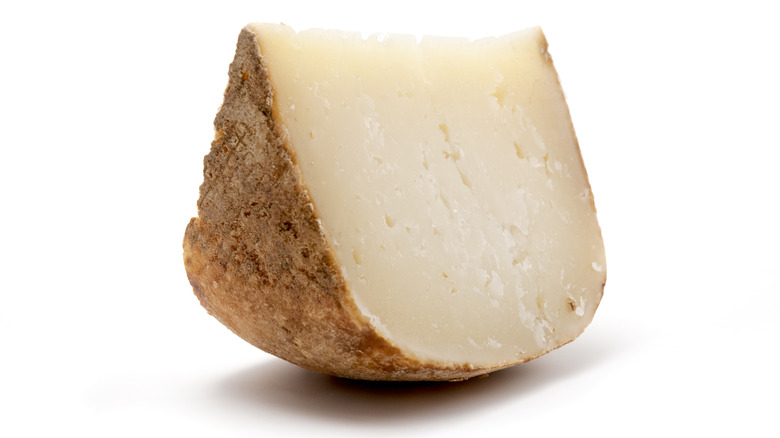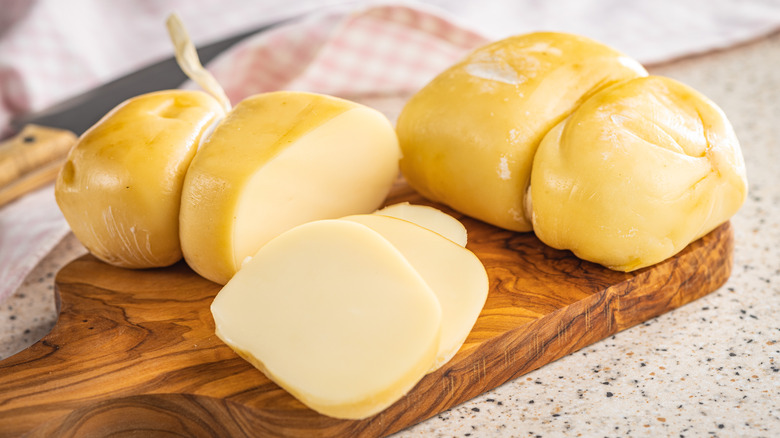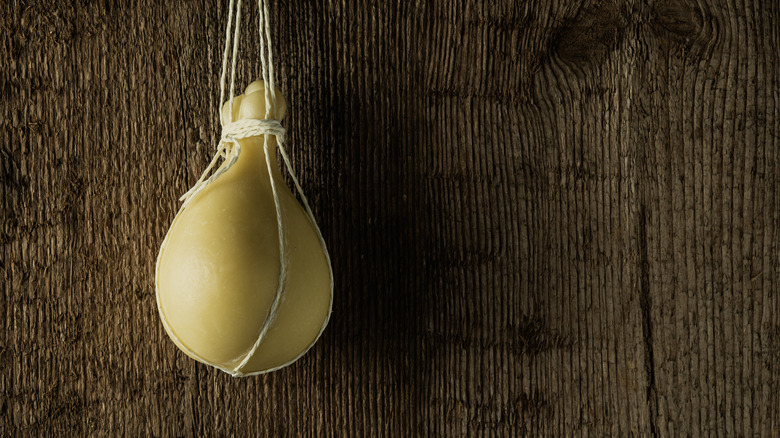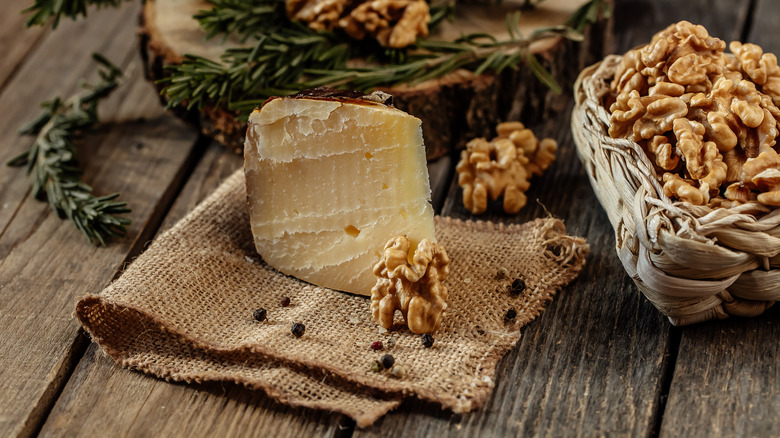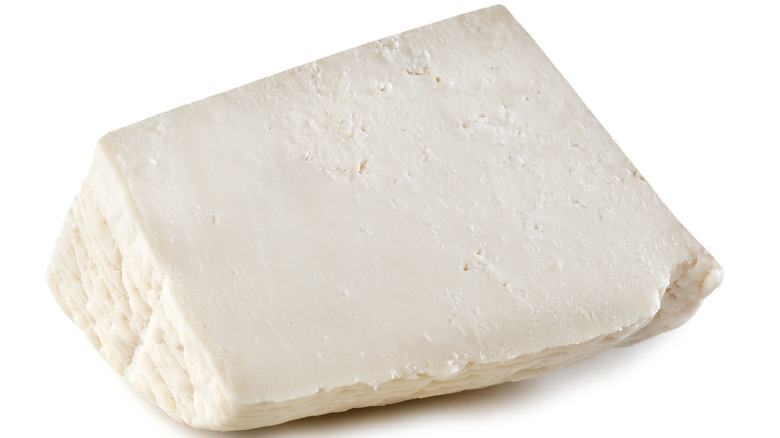17 Italian Cheeses You Need To Try At Least Once
Say cheese! On second thought, say "formaggio" — because today we're taking a deep dive into the wonderful world of Italian cheeses. Italy has such a rich, complex history that you can hardly dig a hole in Rome without running into an ancient artifact. This is a history that you can tell with cheese. From the rugged mountains in the north to the sun-baked plains in the south, Italy has a variety of different landscapes, each one bearing a different culture and, of course, different cheeses.
Some popular Italian cheeses have histories that reach back thousands of years. The ancient Romans were known to be diligent in the art of cheesemaking, with some Roman homes boasting an extra kitchen dedicated to making and storing cheese. While things have changed since then, many cheeses are still made using the same methods that were used all those years ago.
Italy is paradise for a cheese lover like myself, and I've been lucky enough to taste my way through the country in search of the best it has to offer. Read on to find out more about the Italian cheeses you need to try at least once.
Pecorino Romano
No trip to Rome is complete without a plate of cacio e pepe, one of the city's famed pasta dishes. And the type of cheese that cacio e pepe always uses is pecorino Romano, a salty, oily cheese that elevates this pasta into the pantheon of Italian dishes that form the country's rich and varied culinary identity.
In Italian, pecorino means "little sheep," which refers to the sheep's milk used to make the cheese. Compared to cow's milk, sheep's milk is fattier and has a distinct tang, which comes through when you taste dishes topped with a dusting of hard, crumbly cheese. Like other high-fat cheeses, at room temperature pecorino tends to "sweat" as fat melts and bubbles up to the cheese's surface, but don't be deterred — this is a perfectly normal process.
Pecorino Romano isn't just delicious; it sustained an empire. Thousands of years ago, pecorino Romano was included as part of the rations allotted to members of the military legions responsible for expanding the Roman Empire.
Gorgonzola
Perhaps Italy's most famous blue cheese, Gorgonzola comes in distinct varieties that offer its enthusiasts a cheesy choose-your-own-adventure story. The "dolce" (meaning sweet) variety of Gorgonzola is aged for less time and has a gently moldy flavor that's not very powerful, making it a palatable choice for those who don't like a blue cheese that's too intense. It's buttery and creamy, which makes it great for sauces and spreading on a fresh piece of crusty bread. On the other hand, Gorgonzola "piccante" (meaning spicy) is aged longer and has the pronounced bite that comes to mind when you think of an odoriferous blue cheese.
This cheese has a protected status, and must be produced in certain areas of Northern Italy to be called Gorgonzola. If you're wondering whether a certain Gorgonzola is the real deal, look for the Protected Designation of Origin stamp on the cheese's packaging. Enjoy this cheese with a bold red wine like a Malbec or a Cabernet Sauvignon, and if you want to incorporate it into a dish, remember that steak and Gorgonzola cheese are the ultimate flavor pairing.
Taleggio
If you walk into a room where somebody's eating Taleggio, you'll know right away. This soft cheese has a strong smell, but don't be afraid; its bark is worse than its bite. Taleggio's flavor is funky and aromatic, but its taste is not as intense as the smell.
For hundreds of years, farmers in Northern Italy have made this cheese from the milk of cows in the Val Taleggio, the picturesque valley that gave this stinky dairy specialty its name. Taleggio is a smear-ripened cheese, meaning early on in the cheese-making process, a salty brine is applied that stimulates the growth of certain bacteria that give it a unique buttery flavor and characteristic pinkish-red rind. Unlike Southern Italy, where pasta reigns supreme, Northern Italian cuisine is dominated by polenta and risotto, and many regional recipes call for Taleggio to give dishes a fatty, cheesy flavor.
Provolone
While most Italian cheeses are named after their place of origin, provolone is named after its shape. In Neapolitan, a language widely spoken in southern Italy, "prova" means "globe" — which refers to the round shape of this cheese. Although it's originally from Southern Italy, most provolone is now made in regions along the Po River in Northern Italy.
They may share characteristics, but there's a difference between provolone and mozzarella. Provolone is a salty, semi-hard cheese made using the stretched-curd technique, which entails heating the cheese up until it takes on an elastic texture and then shaping it into balls. There are two main types of provolone. Provolone dolce is the younger variety; it's aged only two to three months and has a milkier, milder flavor. Provolone piccante is aged considerably longer, which gives it time to develop a zesty, more piquant taste for those who like a bit more of a bite. A classic cheese for an antipasti platter, provolone pairs nicely with salty salami, olives, and pepperoncini.
Fontina
Originating in the Aosta Valley near Italy's border with Switzerland, Fontina cheese is believed to be named after a bucolic patch of mountain grassland. Farmers in the region have been producing this semi-soft cheese since at least the 13th century, and a castle in the area features a Middle Ages fresco that shows this famous cheese being sold in a market. While variations of this cheese are made around the world, only Fontina labeled "DOP" (Denominazione di Origine Protetta) is protected by EU laws to designate its specific Aosta Valley origin — and finding that marking is how to make sure you're buying authentic Fontina cheese.
Fontina starts with unpasteurized milk from Valdaostan Red Spotted cows, which roam the Aosta Valley's mountainous pastures. The fresh milk is cooked and allowed to age for at least three months. The result is a pale yellow cheese with a slightly nutty flavor that melts beautifully. Fontina cheese is the star ingredient in Italian fonduta soup, which can be enjoyed as a thick treat similar to fondue during the colder months — but it's a cheese worthy of being on your plate year-round.
Parmigiano Reggiano
It's incredible to think that one of the world's most famously delicious cheeses was once just a means to an end. Parmigiano Reggiano's origins began with monks in the Middle Ages who were looking for a way to increase the shelf life of dairy resources. The result was so successful that the cheese is now grated over steaming hot plates of pasta all over the world.
In Europe, cheese labeled Parmigiano Reggiano is protected by laws stipulating that it must come from certain areas in and around the Emilia-Romagna region of northern Italy, where it originated. American regulations are not as strict, and there are many brands of lower-quality Parmesan cheese for sale in the U.S. But the flavor of real Parmigiano Reggiano is unmistakable. Salty and savory with a bit of umami intensity, this cheese elevates all kinds of Italian specialities to the next level.
Burrata
If you're a cheese fan, you know what it's like to cut into a ball of burrata. Your knife descends through the stretchy, solid layer of mozzarella to reveal the lush stracciatella filling of mozzarella strands drenched in sweet cream. While some cheeses on this list have histories that date back thousands of years, local lore has it that burrata was invented in the 1920s by a Puglia cheese maker who was looking for a way to use dairy leftovers.
These days burrata is famous as an upscale appetizer from Denver to Dubai. You can eat it on its own or on top of a pizza or salad, but the best way to serve burrata cheese is simply with a drizzle of good Italian olive oil, a dash of flaky salt, and a nice hunk of warm, crusty bread.
Mascarpone
Unlike the salty, aged cheeses that make up the bulk of this list, soft mascarpone is subtly sweet and packs a delicate, decadent flavor that is the key to many Italian dishes. Originally from Italy's Lombardy region, mascarpone is a spreadable cheese made using fresh cream, which is curdled with an acid and then strained to remove the liquid.
Mascarpone is often compared to cream cheese, but it has a less acidic taste and a fattier texture. While it's most famously used in tiramisu, you can also add a dollop to lasagna or soup to give the dishes an extra richness. Some people swear by mascarpone instead of cream cheese to make luscious cheesecake. If you can't find mascarpone at the grocery store, it's simple to make it yourself at home with heavy cream and lemon juice.
Asiago
If you're fresh out of Parmesan, or if you're just looking for a different salty Italian cheese to grate over your pasta, it may be time to try Asiago. This Alpine cheese hails from the northern Italian province of Vicenza, and its flavor depends on whether it's young or aged.
Made using whole milk and aged about a month, young Asiago (called Asiago pressato) is soft, supple, and has a pale yellow color. Its velvety texture melts beautifully, so it's great for dripping over slices of meat on a hot sandwich, or served in cubes on a cheeseboard. Aged Asiago (Asiago d'allevo) is made with partially skimmed milk and aged for at least several months, and up to two years. The longer it ages, the more intense, funky, and salty its flavor becomes. It's also got a drier, crumblier texture, and is a great way to add some salty umami to a dish.
Ricotta
With famous appearances in a range of smash-hit dishes from cannoli to lasagna, ricotta is the Meryl Streep of Italian cheeses. Fresh, rich, and milky, this white cheese one of the few dairy delicacies on this list that you can make at home — no cheese cave needed. While it's customarily made with sheep's milk, you can use goat, cow, or even water buffalo milk, if you happen to have some on hand. The only other ingredient you need is an acid. Lemon juice, citric acid, or even vinegar will do.
What's important is that you heat up your ingredients low and slow when making ricotta cheese, because if you scorch your milk, you'll ruin the delicate sweetness that makes this cheese so uniquely delicious. Once the curds separate from the whey, just strain them for a fresh, delicious mound of ricotta that will up the flavor and texture of a whole slew of Italian dishes.
Grana Padano
Whether or not you adhere to a certain faith, you can appreciate the contributions that religion has provided the world of Italian cheese. One such blessing that we can all be thankful for is Grana Padano, one of the best ingredient swaps for Parmesan cheese. A hard, salty cheese invented by monks in the Po River valley of Northern Italy almost 900 years ago, "Grana" translates to "grainy," referring to the texture of this cheese similar to Parmigiano Reggiano, which is made using a similar technique in a nearby region.
Both of these historic Po River valley cheeses are shielded by European law with Protected Designation of Origin classification. The regulations designate rules about the cheese making process that must be adhered to, which include requirements for the geography of production facilities, and even the source of the feed eaten by the cows that produce milk for Grana Padano.
Pecorino Toscano
What's in a name? The story of pecorino Toscano, for one. Pecorino refers to the sheep that produce milk for this tangy cheese, while Toscano specifies the cheese's Tuscan heritage. If you're lucky enough to be ambling around Tuscany, you'll note that pecorino Toscano is made in different villages with slight variations in tasting notes, though the cheese is all produced in generally the same way.
Pecorino Toscano is practically part of the Tuscan DNA. Historians believe that a form of this cheese was made by the Etruscans, a civilization that existed in the region thousands of years ago. But it wasn't until 1996 that pecorino Toscano received its Protected Designation of Origin status, regulating the production of this culturally significant cheese. With a milder flavor than pecorino Romano (its more famous cousin), pecorino Toscano is nutty and a tad sweet. It's a great addition to an Italian cheese board, or you can shave it on top of salads, greens, or pasta.
Scamorza
If the words milky, smoky, and salty have you salivating, then you need to try scamorza cheese. Like mozzarella, scamorza is a stretched curd cheese, meaning that it's made by kneading cheese curds until they have a smooth, elastic texture. The cheese is molded into rounds that are tied with a string and hung up to age, giving them a distinctive pear-shaped form. Native to Italy's Basilicata region, you're likely to encounter this cheese if you spend time in the country's southern half.
Like other young cheeses with high moisture content, scamorza is a magnificent melting cheese. Its mild taste and velvety texture can transform a hot sandwich or a baked pasta into a gooey wonderland of Italian flavor. When it's fresh, scamorza tastes like mozzarella, but it's often smoked, which turns the white cheese a pale brown on the outside and gives it a woody, umami finish.
Stracchino
It wouldn't be easy being a cow that produces milk for stracchino cheese. In Italian, the word "stracca" means "tired," and stracchino got its name because the cows that provided milk for this cheese had quite the workout while being herded around the rugged mountains of Northern Italy. Milk from these tired cows has less fat and protein, which gives it a unique taste that translates into a cheese with a gently sour flavor.
What makes this cheese unique is its texture. Aged for just 20-60 days, stracchino doesn't have a chance to develop a real rind, so the cheese is super creamy and typically sold in tins. Because of its soft consistency, stracchino is great for spreading, and it has a gentle taste that can go with sweet or savory foods. Slather a piece of toast with a layer of stracchino and cover it with thinly sliced prosciutto or a chunky fruit jam — or even try a Nutella-stracchino grilled cheese sandwich recipe.
Caciocavallo
Maybe the charm of caciocavallo is in its unique teardrop shape, or the fact that it's tied by a string and hung up to age, or that its name is widely translated to "cheese on horseback." But the most charming thing about this cheese is that it's delicious. Similar in taste and texture to provolone, this stretched-curd cheese is originally from Southern Italy, where it remains a favorite among locals.
Like other stretched-curd cheeses, when it's young, caciocavallo has an elastic, springy texture and a mild taste perfect for those who aren't as adventurous when it comes to the funky flavors of sharper aged cheese. But don't bank on finding this cheese at your local Stateside grocery store. Caciocavallo doesn't have a big following in the U.S., and much of the cheese in Italy is still produced by hand in small batches. So if you want to get your hands on a fresh piece of this cheese, book a flight and start practicing your Italian!
Montasio
Tucked in Italy's northeast corner, the Friuli-Venezia Giulia region lies astride the Julian Alps, a rugged mountain range with rocky peaks and picturesque meadows. It was once also home to the monks who invented Montasio cheese during the Middle Ages. While it isn't a household name in the U.S., Montasio remains a popular cheese in Italy.
As is true of many cheeses, the flavor of Montasio changes significantly depending on how long it's aged. The younger version has a mild flavor, a very pale yellow color, and a creamy texture, while the older version has a crumbly texture and a saltier, more complex taste vaguely reminiscent of Parmesan. It's famous for being the key ingredient in frico, Italy's cheesy, potato-filled comfort food, which is one of Friuli-Venezia Giulia's most renowned dishes. Made by frying sliced onions, grated potatoes, and Montasio scraps in oil, some frico recipes also contain meat, herbs, and spices — but the cheese is always the star.
Ricotta salata
I'm always rooting for the underdog, and in the world of Italian cheeses, the underdog is ricotta salata. In fact, this is the Italian cheese you should be using more of, according to Giada di Laurentiis. While regular ricotta cheese is easy to make in the comfort of your kitchen with whatever milk you want, ricotta salata is made with fresh sheep's milk ricotta that is salted and pressed until it becomes a glorious white block of crumbly, salty flavor.
Unlike most of the cheeses on this list, ricotta salata is not at its best when eaten by itself. It really needs to be in a supporting role to make a dish shine. But if you know how to use it, the options with ricotta salata are endless. It can add a salty, flavorful kick to pasta, salad, or even a burger.
